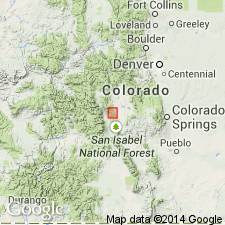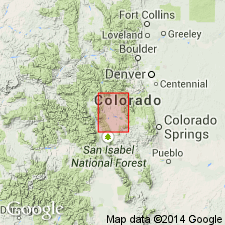
- Usage in publication:
-
- Buffalo Peaks andesite
- Modifications:
-
- Original reference
- Dominant lithology:
-
- Andesite
- AAPG geologic province:
-
- South Park basin
Summary:
Pg. 900, 990, 999, 1000. Buffalo Peaks andesite. Extrusive, lies on truncated surface of Paleozoic strata (Permian) affected by the syncline extending northerly from valley of Trout Creek in sec. 3, T. 14 S., R. 77 W., past Pony Spring, to northeast spur of Buffalo Peaks in Salt area, Park and Chaffee Cos., central CO. Age is Tertiary.
Source: US geologic names lexicon (USGS Bull. 896, p. 289).

- Usage in publication:
-
- Buffalo Peaks andesite
- Modifications:
-
- Areal extent
- Dominant lithology:
-
- Andesite
- AAPG geologic province:
-
- South Park basin
Summary:
Pg. 103-105, pl. 1. Buffalo Peaks andesite. On Hall Buttes, andesite varies from gray to black, with phenocrysts of hornblende and pryoxene. Flow structure common, and platy jointing often well developed. Small amounts of agglomeratic material at base of volcanics. Thickness between 500 and 600 feet at westernmost end of West Hall Butte and decreases to between 200 and 300 feet at east end of East Hall Butte; much thicker on Buffalo Peaks. An early Oligocene age is suggested.
Source: US geologic names lexicon (USGS Bull. 1200, p. 523).

- Usage in publication:
-
- Buffalo Peaks Andesite*
- Modifications:
-
- Age modified
- AAPG geologic province:
-
- South Park basin
- Eagle basin
Summary:
Is a light- to dark-gray or brownish-gray, porphyritic andesite with phenocrysts of plagioclase, hornblende, and pyroxene. Hornblende phenocrysts are prominent; some are as much as 2 cm long. Lower part is a reddish-brown breccia that contains fragments of moderately welded red and underlying ash-flow tuff; the contact between breccia and underlying tuff is disconformable. The top of the andesite is eroded. Is 565 ft (172 m) thick at Buffalo Peaks. The Oligocene? age is determined from its stratigraphic position above the Wall Mountain Tuff (considered early Oligocene age in earlier reports). Is preserved as erosional remnants at East and West Hall Buttes, and East Buffalo Peak in Park Co, and at West Buffalo Peak in Park and Chaffee Cos, CO in South Park, South Park and Eagle basins.
Source: GNU records (USGS DDS-6; Denver GNULEX).
For more information, please contact Nancy Stamm, Geologic Names Committee Secretary.
Asterisk (*) indicates published by U.S. Geological Survey authors.
"No current usage" (†) implies that a name has been abandoned or has fallen into disuse. Former usage and, if known, replacement name given in parentheses ( ).
Slash (/) indicates name conflicts with nomenclatural guidelines (CSN, 1933; ACSN, 1961, 1970; NACSN, 1983, 2005, 2021). May be explained within brackets ([ ]).

